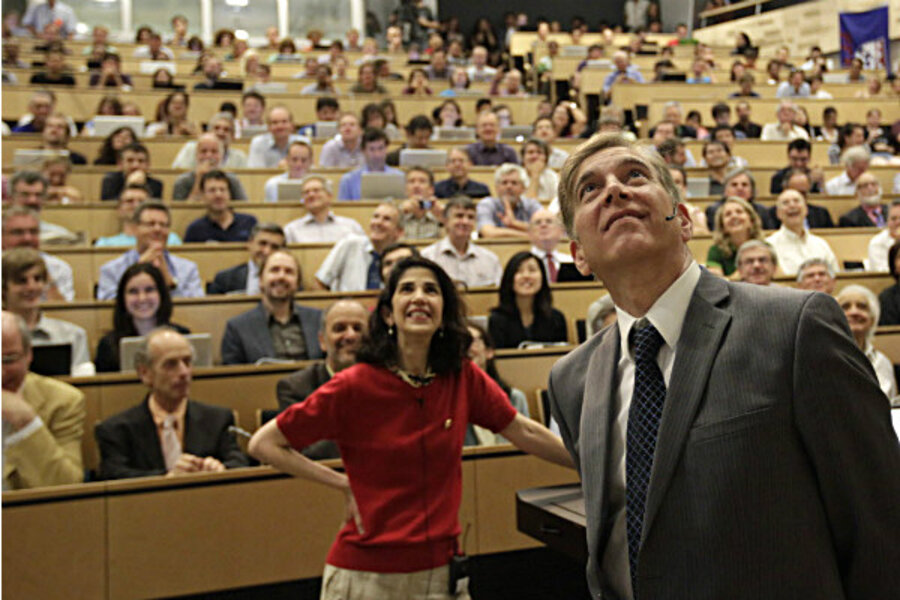Higgs boson discovery could usher in 'new, wonderful technologies,' says physicist
| Wichita, Kan.
In the pursuit of seemingly infinite questions, there can only be more understanding.
That was the prevailing sentiment of physicist Nickolas Solomey on Wednesday after the European Center for Nuclear Research — better known as CERN — announced the likely discovery of the Higgs boson, a particle that scientists at the Geneva, Switzerland-based research facility believe could unlock some of the answers to our universe’s origin.
The Higgs, which until now had been purely theoretical, is regarded as key to understanding why matter has mass, which combines with gravity to give all objects weight. The particle’s existence is considered fundamental to the creation of the universe.
“One question is that now that we know there is this all-permeating Higgs field … where did it come from?” asked Solomey, the director of physics at Wichita State University since 2007. “How does it act? Maybe once we know that we can start to use it.”
Solomey has several close ties to the half-century-long saga that ended Wednesday and began with a theory from Scottish scientist Peter Higgs and others in 1964 that such a particle existed.
The Higgs boson’s commonly used nickname in popular culture — the “God particle” — was coined by Solomey’s close friend Leon Lederman, in the title of Lederman’s popular book on particle physics, “The God Particle: If the Universe Is the Answer, What Is the Question?”
The nickname is cringe-inducing for most scientists because it indicates the particle’s discovery might tell us the genesis of creation. Solomey chuckled at its reference on Wednesday. Lederman recruited Solomey away from the University of Chicago to come work at the Illinois Institute of Technology in 1999.
“Leon just needed a catchy title for his book,” Solomey said. “I know he regrets it. We’ve known each other for a long time.”
Solomey, a Pittsburgh native, worked at CERN from 1985 to 1992 under Noble Prize winner Georges Charpak and earned his Ph.D. in particle physics from the University of Geneva in 1992.
While at CERN, Charpak and Solomey worked to create high-density states of matters — states that would have been found at the beginning of the “Big Bang” — the cosmological event that explains the early development of the universe.
“We did heavy ion collision,” Solomey said. “Trying to create an environment too hot for protons and neutrons. The key to any misconception of our work is that we were creating conditions that were at the beginning of the Big Bang. What we did was so controlled and in such a small space … you can’t release more energy than you put in.
“And we were not generating huge amounts of energy.”
The discovery of the Higgs boson at CERN does raise the question: If scientists are creating a particle that professes to be the place where all mass comes from, how can they contain its growth? Does the Higgs boson present any danger to the planet?
“There’s no danger because it takes a certain amount of energy to make it and you can’t get any more out of it than you put in,” Solomey said. “The (particle accelerator) is producing a certain amount of power and it’s not like it’s uncontrolled or there are an infinite number of (particles).
“It is producing elementary particles, not anywhere near to producing a dangerous amount.”
Solomey also stressed that the discovery of the Higgs boson could take a long time to fully understand, comparing it to the discovery of the electron by J.J. Thomson in 1897.
“Imagine that after Thomson discovered the electron, that it took a good 50 to 100 years to learn how to use it, how to manipulate it,” Solomey said. “It showed us how to make televisions, how to make transistor radios, how to make medical imaging … how to sterilize our foods.
“The discovery of the Higgs boson could lead to very new things … imagine anything that has mass and how it couples to different masses. We could apply these things to new, wonderful technologies. To do things when it’s critical to our basic science, our basic survival, always leads to an advance in applications.”





